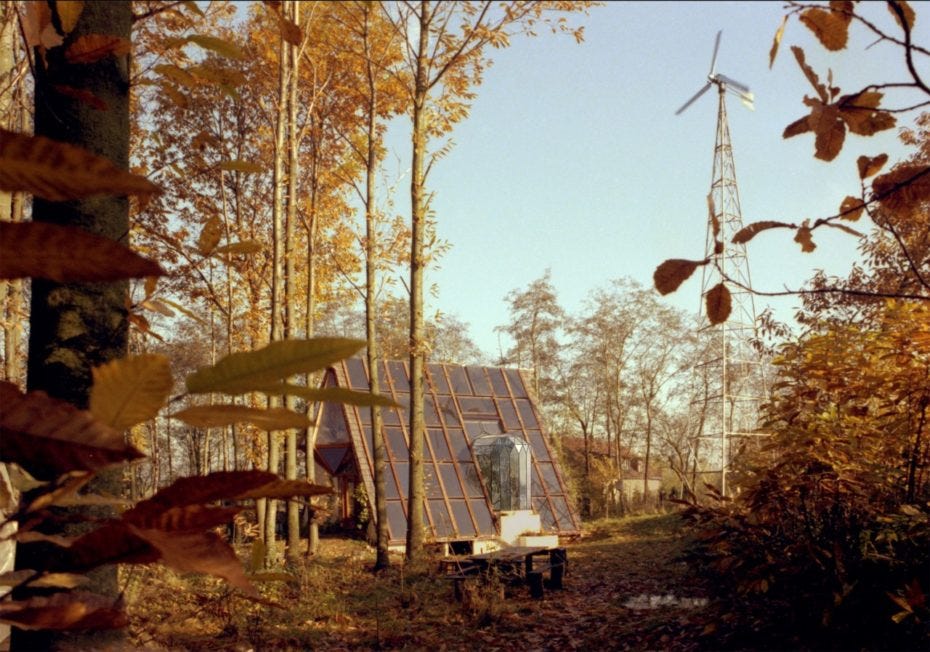Solarpunk Forever 🌞 Tim Pool is a lying and stupid hack 🤖 Digimon fights Political Correctness 🦆 A Goose flying upside down
Also, a good video about how to forgive yourself. Watch it. You might need it.
Solarpunk Forever!
Solarpunk has a moment. Die ästhetische Bewegung, die einen optimistisch-utopischen Ausblick auf die Welt nach der Adaption an den Klimawandel zeigen will, verfolge ich seit ungefähr 2014, und sie hat bislang ein ruhiges Dasein geführt im Schatten ihres literarischen Verwandten, der bislang eher von dystopischen Bildern beherrschten Climate Fiction.
Nun wurden innerhalb weniger Wochen ein Solarpunk Manifest veröffentlicht, es erschienen eine ganze Reihe von Artikel, die sich auf diese Utopie grün-urbaner, post-industrieller Erneuerung beziehen in Städteplanung und Architektur. All dies sind für mich Konkretisierungen dieser bislang eher lose definierten Ästhetik, die irgendwo bei den Design Fictions von Architektur-Büros angesiedelt war, in sichtbaren kulturellen Manifestationen einer neuen utopischen Sichtweise auf den Klimawandel.
Auch die Klima-Berichterstattung ändert derzeit ihre Tonalität von Doom-and-Gloom zu optimistisch-utopischen Kampfansagen an die Energieerzeuger:
“The most harmful lie being spread about climate change today is not that it is fake,” Emily Atkin, writer of Heated, wrote in a recent newsletter. “It’s that nothing you can do can help save the world.”
Atkin is part of a growing army of online activists taking a different tone in their coverage of global warming, prioritizing hope over fear. My discovery of this genre started when I read an earlier piece by Atkin about how news outlets tend to approach even good climate news from a negative lens.
“There will be more opportunities to get it right in the future; more good days for the planet are coming,” she wrote.
Ob diese post-dystopische Haltung zum Klimawandel und ihre Ästhetik, die sich in Solardächern und Elektroautos, in neuen Stadtplanungen und Mobilitätskonzepten, in der Debatte um autofreie Städte oder in DIY-Projekten wie den Prinzessinengärten in Berlin zeigt, die nächsten Katastrophenmeldungen überlebt, und dann als Solarpunk durchsetzt oder schlicht als post-industrielle Kultur gelebt wird, werden wir sehen. Zweifelsohne wird Solarpunk aber unseren Alltag jenseits der hedonistischen Urbanität der 80er und 90er Jahre prägen und der kommenden Generation ihren Stempel aufprägen.
This is Solarpunk:
I don't subscribe to every point in this Solarpunk Manifesto, but it's a good start: "Solarpunk is at once a vision of the future, a thoughtful provocation, a way of living and a set of achievable proposals to get there."
Inside the Imaginarium of a Solarpunk Architect: "The Solarpunk ideology found its roots on the internet in around 2008, envisioning how our world could look if humanity succeeded in solving major modern contemporary challenges such as climate change and pollution. But since the 1950s, Luc Schuiten (now 77 years old) has been designing for the future urban landscape based on his concept of “archiborescence,” blending organic and manufactured elements for homes, commercial buildings and even entire cities of tomorrow. Whether or not it was his intention, Schuiten’s work, and particularly his illustrative style, has influenced an entirely new art and media movement that encourages sci-fi culture to redirect its energy towards manifesting a more utopian vs dystopian planet."
Roses out, olives in: the new English garden in a time of climate crisis: "Oxford Botanic Garden is 400 years old, but the climate emergency is forcing a review of what seeds it sows for the future".
The Need for a New Garden City Movement: "Imagine a small city, built from scratch, overflowing with parks and green space, dense enough to be walkable but not so much to feel crowded. A place where the land is collectively owned, houses are quirkily individualized rather than cookie-cutter, and rents from the land support the creation of luxurious public spaces—like a farmers market housed in a crystal palace, with waterfalls throughout. Rent is low, jobs pay well, there is little inequality, and there are good public transit networks. This is the sort of place envisaged by the Garden City movement, an ambitious and eccentric school of thought about urban planning that popped up in early 20th century Britain and actually produced several complete cities as well as inspired planners across the world for decades."
Drawing pictures of cities - We need to visualize the kinds of urban environments we want to live in: "This is a famous picture by the artist Imperial Boy 帝国少年, who works in the anime industry. I sometimes claim that the entire genre of solarpunk is simply a riff on this picture. (...) the secret of Imperial Boy’s magic. Not some biopunk science fiction that merges foliage and concrete, nor some cyberpunk construction method that creates buildings in improbable shapes. It’s just good urban design (...) To create the future we must first dream the future."
Overview of the Solarpunk World: "The footprint of a civilization is greatly influenced, if not largely defined by, the logistics of its predominant forms of energy and the modes of transportation they enable. This, in turn, establishes the context in which production must function with its subsequent techniques and materials influencing the collective aesthetic of the habitat."
Solarpunk Illu Competition from 2019 with some beautiful stuff.
Paul Graham Raven schließlich liefert in seinem Review des Buches "Green Utopias: Environmental Hope Before and After Nature" (Amazon) eine sehr einleuchtende Erklärung für die allgegenwärtige Präsenz von apokalyptischen Bildern und Dystopien in Literatur und Film während der letzten 20 Jahre. Die mittlerweile gesellschaftlich durchgesetzte Akzeptanz des menschengemachten Klimawandels erzeugt ein Gefühl des vom "Ende der Natur". Ideengeschichtlich hat sich seit der Aufklärung ein Bild des Menschen durchgesetzt, das über die Natur erhaben scheint und einen Gegensatz zu ihr darstellt. Dieses Gegensatzpaar wird durch den massiven Einfluss des Menschen auf elementare Systeme wie das Klima aufgelöst, der Mensch war nie aus der Natur herausgelöst, weshalb die alte Utopie der ökologischen Bewegung "Zurück zur Natur" in sich zusammenfällt. Im künstlerischen Ausdruck des kollektiven Unterbewusstseins erhält man deshalb vor allem Apokalypsen-Filme von Roland Emmerich und nur wenige Utopien.
Der Solarpunk ist deshalb nicht nur als vorübergehende Modeerscheinung zu lesen, sondern als grundlegende Änderung in der Haltung zu den neuen kulturellen Lebendsbedingungen des 21. Jahrhunderts.
In philosophical and social-theoretical terms, this is “the end of nature,” and there are two major positions upon it. The first (exemplified by Bill McKibben) is a sort of romantic expression of loss toward a sense of nature as something distinct from humanity. The second (exemplified by Bruno Latour) is a claim that any nature separate from humanity was always-already a fiction, a mere dichotomy of Enlightenment thought which if anything encouraged and accelerated the externalisation and despoilment of the environment in capitalist production. In both cases, the early environmentalist urge to “save” or “return to nature” is undermined as a basis for green hope, resulting in the dearth of formal green utopias by contrast to the earlier phase, and a concomitant shift toward post-apocalyptic and dystopian futures in the literary sphere.
As Garforth notes, “detailed images of sustainable societies are not currently conspicuous in mainstream environmentalism […] space for overtly utopian imaginaries seems to have shrunk”. The era of blueprints seems to be over—and that’s not entirely a bad thing—but “green hope” nonetheless “emerges against the grain, as an echo or desiring trace […] often expressed in images rather than words, often entangled in commodified desires rather than clearly in opposition to them” (ibid.). It doesn’t get a mention in Green Utopias, but I would argue that the solarpunk scene is perhaps an exemplar of this trend toward environmental utopianism as a predominantly aesthetic phenomenon; its tacit avoidance of the political underpinnings of its preferred future makes it very much of a part with the “after nature” phase of green hope.
How a Dummy gamed Journalism for fame and profit
The Daily Beast mit einem langen Stück über Rightwing Darling und Youtube-Star Tim Pool, den ich vor ungefähr einem Jahr endlich aus meinen Subscriptions gekickt habe, nachdem sein aggressives Aufpeitschen seiner Rightwing-Fanbase und seine offene Kriegsgeilheit nicht mehr zu ertragen waren. Bei Daily Beast erfahren wir nun, wie er seinen Zuschauern auf Youtube anlügt und warum seine angeblichen Street Creds als Reporter "On The Ground" nur heiße Luft sind. Dazu reden sie mit ehemaligen Kollegen und präsentieren genug Zahlenmaterial und Hintergrundrecherche um ein recht detailiertes Bild eines Wichtigtuers zu zeichnen, der nicht viel kann, außer sein Maul auf Youtube aufreißen und keine wirkliche Ahnung von den Themen hat, über die er quatscht.
Despite his continued insistence on being viewed as a “center-left” truth-teller, a Daily Beast review of hundreds of hours worth of Pool’s commentaries revealed a consistent if broad eschatology: No matter which ginned-up atrocity is roiling the online right on a given day, Pool routinely will deem it a crucial sign pointing towards a civilization-ending crisis or imminent civil war. (Sometimes, he’ll declare that a civil war is already underway.) Who is to blame? A vaguely defined yet omnipresent and menacing left-wing other.
As a matter of course, Pool depicts people and groups on the left as potential bomb-tossing radicals or authoritarian lunatics; cultural shifts or gestures towards social and racial justice will lead to chaos and gulags stocked with the victims of morality policing, like the McCloskeys, according to Pool; and if the police are now siding with terrorists like “BLM and antifa” perhaps the time has come to flee the cities and stock up on firearms, as Pool himself has done.
“They will never stop coming. They will take your job away. They will come for your parents,” Pool said in a keyed-up June 2020 livestream lambasting those who won’t push back against the horde of “woke” cultists. “You will do something wrong, they’ll fire your mom. They will come to your house with fireworks and guns.”
Fraktale Schraubzwinge
So, this guy restored an antique fractal vise which can grab anything, and then this guy 3D-printed a fractal vise, and this guy, and this guy too. [This guy] built "Morphing Fractal Engraving Vise Jaws" made from titan and now I want a fractal Schraubzwinge too, though I'd just look at it randomly putting any shit in there that comes to mind, like, i dunno, a cheeseburger (def something to eat), my sunglasses, a smartphone maybe, my penis ofcourse (maybe not), a book, what have you.
Beautiful Video from the School of Life about how to forgive yourself. I figured many so-called hackers from the CCC and my former "friends" and "colleagues" from the old blogosphere should watch. They'll need it. Because I will never, ever forgive or forget the cruel, inhumane shit they’ve done to me. Forgive yourself, because I will not.
Some years ago some dev showed off a concept for a game where you strolled through chinese legendary Kowloon Walled City as a cat. That game is ready now and available for pre-order on Steam and it's called "Stray".
It doesn't mention Kowloon anymore, which has become an abandoned cyber city. Supposedly the chinese authorities didn't like the glorification of autonomous experiences of Kowloon in all its dirty mud and criminal nastiness (from 1950 to 70 Kowloon was completely controlled by the Triads within their modern-imperial communist/capitalist reich, but what gives, here's the cat:
This guy build a thing with one trillion billion video feedback loops creating beatiful fractals from any video signal. This is some supreme shit.
A shortstory about new Gawkers short fiction section in 2 tweets:



Here's a good tweet about Bill Gates adventures in shitland:


"Digimon fights against a new villain called 'Political Correctness', which uses a special attack called 'Cancel Culture'." You just can't make this shit up.
Jeff Tweedy from Wilco has a Substack now and anything Wilco is great news.
I've now read two serious considerations (one good, one bad, both serious) of Limp Bizkit these days and what can I say, I was listening to their Three Dollar and Significant Other some weeks ago and fuckit, their cover of George Michaels "Faith" is a onggood cover.
Wissenschaftler haben ein Konzept entwickelt, um Kreativität objektiv zu messen, indem sie den semantischen Abstand zwischen Wort-Assoziationen erfassen. Desto größer der semantische Bedeutungs-Abstand von frei assoziierten Wörtern, umso kreativer der Mensch. Ein Beispiel: Ich gebe das Wort "Grün" vor und Person A fällt dazu "Laub" und "Gras" ein, beides Pflanzen, während Person B "Tom Green", "Gras" und "Iren" einfällt. Person B wäre in diesem Fall die objektiv kreativere Person mit den semantisch variantenreichsten Ideen.
Goose flying upside down is simply showing off, say experts. Whatever. A goose flying upside down showing off is a jerk, that's what I say. Fuck that goose.
This is how a jerk flies. Look at that jerk showing off. What an ass.
Enjoy some VQGan Tardigrades (click through to see the whole thread, there’s more.)

















